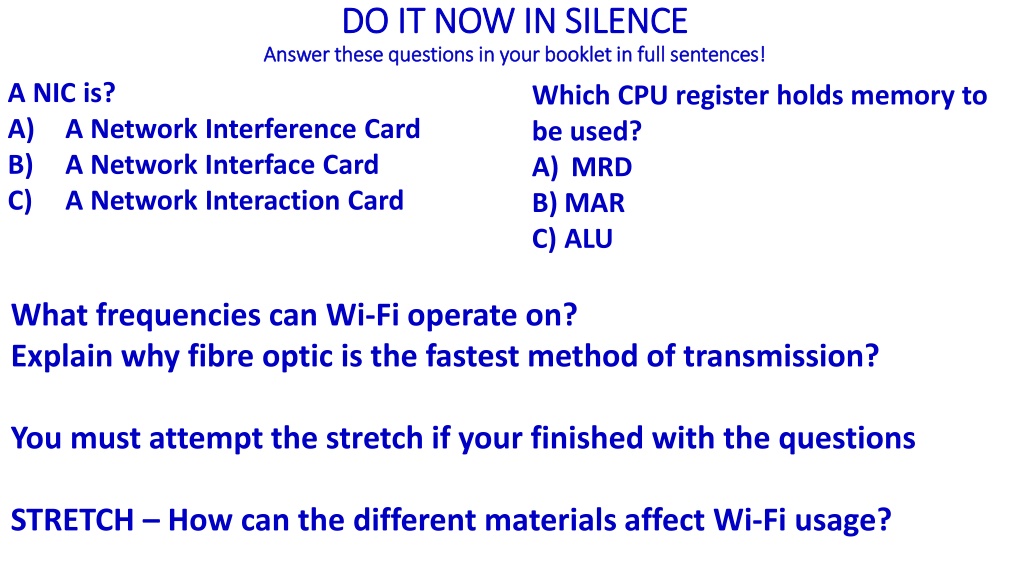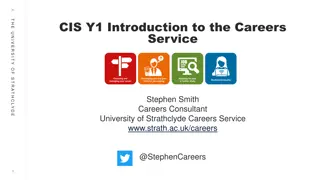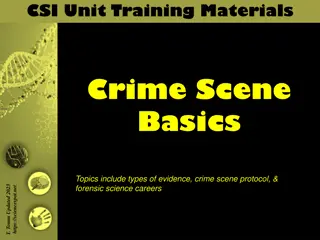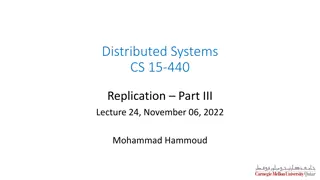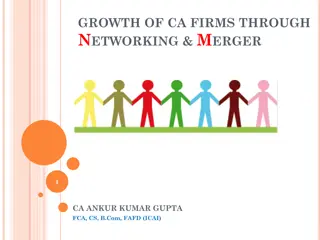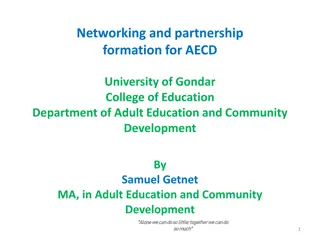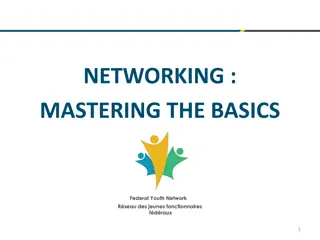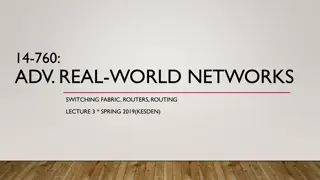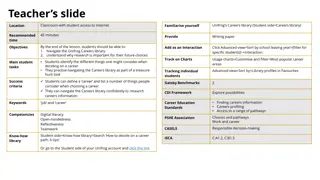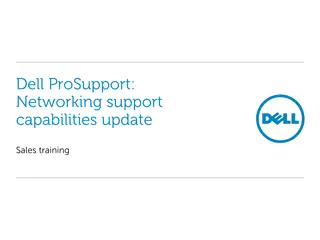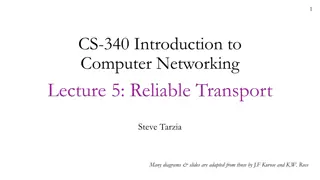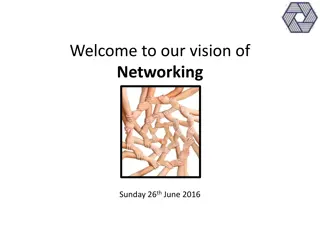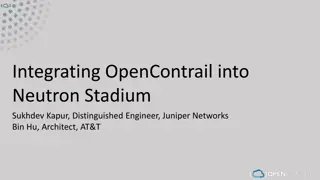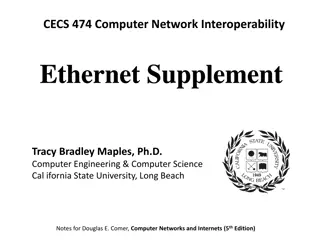Networking Fundamentals Explained: Protocols, Models, and Careers
Explore the key concepts of networking, including NIC, CPU registers, Wi-Fi frequencies, fiber optic transmission, and material impacts on Wi-Fi usage. Learn about protocols, OSI and TCP/IP models, and career paths in network management and development.
Download Presentation

Please find below an Image/Link to download the presentation.
The content on the website is provided AS IS for your information and personal use only. It may not be sold, licensed, or shared on other websites without obtaining consent from the author. Download presentation by click this link. If you encounter any issues during the download, it is possible that the publisher has removed the file from their server.
E N D
Presentation Transcript
DO IT NOW IN SILENCE DO IT NOW IN SILENCE Answer these questions in your booklet in full sentences! Answer these questions in your booklet in full sentences! A NIC is? A) B) C) Which CPU register holds memory to be used? A) MRD B) MAR C) ALU A Network Interference Card A Network Interface Card A Network Interaction Card What frequencies can Wi-Fi operate on? Explain why fibre optic is the fastest method of transmission? You must attempt the stretch if your finished with the questions STRETCH How can the different materials affect Wi-Fi usage?
DO IT NOW IN SILENCE DO IT NOW IN SILENCE Answer these questions in your booklet in full sentences! Answer these questions in your booklet in full sentences! Which CPU register holds memory to be used? A) MRD B) MAR C) ALU A NIC is? A) B) C) A Network Interference Card A Network Interface Card A Network Interaction Card What frequencies can Wi-Fi operate on? Wi-Fi operates on 2.4Ghz and 5.0Ghz Explain why fibre optic is the fastest method of transmission? Because fibre optic uses light and light is one of the fastest things in the universe. STRETCH How can the different materials affect Wi-Fi usage? Due Wi-Fi being a radio wave copper and lead etc. can absorb the radiation and then stop it from reaching its destination.
Networking Networking Lesson 2 Keywords for types of Websites Protocol A set of instructions Transmission Sending information from one place to another Messaging When we send an instruction or information to another device
We Are Learning To- To understand the similarities and differences between the OSI and TCP/IP Model What I m Looking For: Define the purpose of the term protocol Describe the process of the OSI and TCP/IP Model Explain the differences between the OSI and TCP/IP Model Careers Focus Network Manager
OSI Model OSI Model We Are Learning To- To understand the similarities and differences between the OSI and TCP/IP Model OSI Model- Stands for Open Systems Interconnection Model. It is used to understanding data communications between any two networked system. There are seven layers in the OSI model. They are as follows: OSI MODEL Application Presentation Session Transport Network Data Link Physical What I m Looking For: Define the purpose of the term protocol Describe the process of the OSI and TCP/IP Model Explain the differences between the OSI and TCP/IP Model Careers Focus Back End Developer
TCP/IP Model TCP/IP Model We Are Learning To- To understand the similarities and differences between the OSI and TCP/IP Model TCP/IP Model- stands for Transmission Control Protocol/Internet Protocol Model. There are four layers in the TCP/IP Model. They are as follows: TCP / IP MODEL What I m Looking For: Define the purpose of the term protocol Application Describe the process of the OSI and TCP/IP Model Transport Explain the differences between the OSI and TCP/IP Model Internet Careers Focus Back End Developer Network Access
OSI VS TCP / IP OSI VS TCP / IP We Are Learning To- To understand the similarities and differences between the OSI and TCP/IP Model OSI MODEL TCP / IP MODEL Application Layer 7 Application Layer 4 What I m Looking For: Define the purpose of the term protocol Presentation Layer 6 Session Layer 5 Transport Layer 3 Transport Layer 4 Describe the process of the OSI and TCP/IP Model Internet Network Layer 3 Layer 2 Explain the differences between the OSI and TCP/IP Model Data Link Layer 2 Network Access Layer 1 Physical Layer 1 Careers Focus Back End Developer
OSI Model OSI Model Layer 1 (Physical) Layer 1 (Physical) We Are Learning To- To understand the similarities and differences between the OSI and TCP/IP Model Physical layer is responsible for transmitting bits over the physical cable. What I m Looking For: Define the purpose of the term protocol Functions Data Encoding Transmissions of bits Describe the process of the OSI and TCP/IP Model Explain the differences between the OSI and TCP/IP Model Careers Focus Back End Developer
OSI Model OSI Model Layer 2 (Data Link) Layer 2 (Data Link) We Are Learning To- To understand the similarities and differences between the OSI and TCP/IP Model Data Link Layer is responsible for controlling the error between adjacent nodes and transfer the frames to other computers via the physical layer. What I m Looking For: Define the purpose of the term protocol Functions Link establishment and termination Frame Traffic control Describe the process of the OSI and TCP/IP Model Explain the differences between the OSI and TCP/IP Model Careers Focus Back End Developer
OSI Model OSI Model Layer 3 (Network) Layer 3 (Network) We Are Learning To- To understand the similarities and differences between the OSI and TCP/IP Model The network layer is responsible for translating the logical network address and names into their physical address What I m Looking For: Define the purpose of the term protocol Functions Traffic control Logical to physical address mapping Describe the process of the OSI and TCP/IP Model Explain the differences between the OSI and TCP/IP Model Careers Focus Back End Developer
OSI Model OSI Model Layer 4 (Transport) Layer 4 (Transport) We Are Learning To- To understand the similarities and differences between the OSI and TCP/IP Model The transport layer is responsible for sending messages between the hosts. What I m Looking For: Define the purpose of the term protocol Functions Delivering messages Session multiplexing Describe the process of the OSI and TCP/IP Model Explain the differences between the OSI and TCP/IP Model Multiplexing This is when we use differing data signal frequencies down one cable so multiple pieces can be sent only using one cable. Careers Focus Back End Developer
OSI Model OSI Model Layer 6 (Presentation) Layer 6 (Presentation) We Are Learning To- To understand the similarities and differences between the OSI and TCP/IP Model The Sessions layer is responsible for establishing the process- to-process communication between the hosts in the network. What I m Looking For: Define the purpose of the term protocol Functions It is used for session establishment, maintenance and termination Provides session support Describe the process of the OSI and TCP/IP Model Explain the differences between the OSI and TCP/IP Model Careers Focus Back End Developer
OSI Model OSI Model Layer 7 (Application) Layer 7 (Application) We Are Learning To- To understand the similarities and differences between the OSI and TCP/IP Model The Application layer provides a range of different services to the application. What I m Looking For: Define the purpose of the term protocol Functions Remote file access Electronic messaging (e-mail) Network Management Describe the process of the OSI and TCP/IP Model Explain the differences between the OSI and TCP/IP Model Careers Focus Back End Developer
TCP/IP Model TCP/IP Model Layer 1 (Network) Layer 1 (Network) We Are Learning To- To understand the similarities and differences between the OSI and TCP/IP Model In the TCP/IP Model, the Data Link layer and the Physical Layer are normally grouped to become the Network Layer What I m Looking For: Define the purpose of the term protocol Functions Delivers data via a physical link Provides error detection and packet framing Describe the process of the OSI and TCP/IP Model Explain the differences between the OSI and TCP/IP Model Careers Focus Back End Developer
TCP/IP Model TCP/IP Model Layer 2 (Internet) Layer 2 (Internet) We Are Learning To- To understand the similarities and differences between the OSI and TCP/IP Model The Internet layer is the primary protocol in the TCP/IP Network layer What I m Looking For: Define the purpose of the term protocol Functions Manages addressing of packets and delivery of packets between networks Breaks down the packets so that they can be dealt with by lower level layer Describe the process of the OSI and TCP/IP Model Explain the differences between the OSI and TCP/IP Model Careers Focus Back End Developer
TCP/IP Model TCP/IP Model Layer 4 (Application) Layer 4 (Application) We Are Learning To- To understand the similarities and differences between the OSI and TCP/IP Model The Application layer in the TCP/IP Model groups the functions of OSI Application, Presentation and Session Layers. What I m Looking For: Define the purpose of the term protocol Functions Refers to standard network services Describe the process of the OSI and TCP/IP Model Explain the differences between the OSI and TCP/IP Model Careers Focus Back End Developer
OSI vs TCP/IP OSI vs TCP/IP We Are Learning To- To understand the similarities and differences between the OSI and TCP/IP Model In your books write the similarities and the differences between the 2 models. What I m Looking For: Define the purpose of the term protocol Describe the process of the OSI and TCP/IP Model Explain the differences between the OSI and TCP/IP Model Careers Focus Back End Developer
OSI vs TCP/IP OSI vs TCP/IP - - Answers Answers We Are Learning To- To understand the similarities and differences between the OSI and TCP/IP Model TCP/IP Model OSI Model Created after the internet became popular Created before the internet became popular What I m Looking For: Define the purpose of the term protocol Supports internet working Doesn t support internet working Loosely layered Strictly layered Describe the process of the OSI and TCP/IP Model Protocol dependant Not protocol dependant Explain the differences between the OSI and TCP/IP Model More credible Less credible TCP reliably delivers packets IP does not All packets are delivered reliably Careers Focus Back End Developer
We Are Learning To- To understand the similarities and differences between the OSI and TCP/IP Model What I m Looking For: Define the purpose of the term protocol Describe the process of the OSI and TCP/IP Model Explain the differences between the OSI and TCP/IP Model Careers Focus Network Manager
WWW I can define the purpose of the term protocol I can describe the process of the OSI and TCP/IP Model I can explain the differences between the OSI and TCP/IP Model EBI I need to revisit the purpose of the term protocol I I need to revisit the process of the OSI and TCP/IP Model I need to revisit the differences between the OSI and TCP/IP Model
